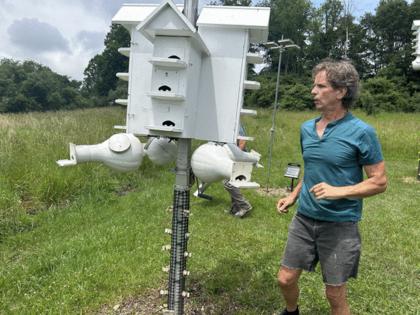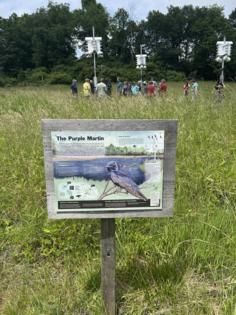How flinging crickets in the air helped save purple martins in Western Pa.
Published in Science & Technology News
PITTSBURGH — One bird spectacle readily observable in Allegheny County right now comes in the form of 100 purple martins swirling above the fields and their condos at Harrison Hills Park.
Nesting in colonies, the handsome dark purple bird is the largest swallow in the nation, boasting a 16-inch wingspan and gobbling up thousands of insects.
In 2000, in light of declining numbers in the region and abroad, a local man developed an emergency feeding technique — flinging crickets in the air for famished martins to eat — to lend a hand.
Purple martin populations have dropped 33% in the last 50 years because of habitat loss and competition from invasive, non-native birds, including English house sparrows and European starlings, according to the Purple Martin Conservation Association, an international nonprofit headquartered at the Tom Ridge Environmental Center in Presque Isle State Park.
Despite the trend, the birds are making a "big comeback" in the region in Allegheny, Armstrong, Butler and Westmoreland counties, said Ken Kostka of Harrison, who manages the Harrison Hills purple martin site and others he established.
Kostka recently opened the Harrison Hills colony to the public for a presentation on history and nesting success at the site, now home to at least 40 pairs. In a field near the park's environmental center, three wooden houses hold nest drawers suspended on 12-foot-tall metal poles that Kostka can lower to check on the birds.
The site has been an active colony since 2015 and is the only county park with a martin colony.
Emergency feeding
It was bleak in April 2000, when purple martins hadn't eaten for three days due to unseasonably cold weather at a Crawford County farm. The site's owner, Andy Troyer, contacted Kostka for help.
Neither wanted to see staggering losses reminiscent of those brought by Hurricane Agnes in 1972, which initiated starvation that decimated over 90% of the purple martin population in Western Pennsylvania.
If the birds are hit with three or more days of continuous rain or temperatures below 50 degrees, their insect prey is grounded, posing major challenges.
Purple martins are aerial insectivores, meaning they live solely off of flying insects. Also, these colony nesters are totally dependent on housing provided by humans in the Eastern U.S.
Back in 2000, when Kostka was serving as a research assistant at the Purple Martin Conservation Association, he heard anecdotal reports of the birds eating dead crickets off the ground and other atypical feeding behaviors.
"We wanted to develop an emergency feeding technique that would keep purple martins from starving in bad weather," he said.
When Troyer contacted the association about the starving martins, Kostka ordered 2,000 live crickets and took them to Crawford County. He and Troyer's son flung the insects into the air where the martins were sitting.
"They ignored the first couple of dozen. Then one purple martin went after a cricket and snagged it out of the air," he said.
Then, more fed on the "flying" crickets, and Kostka and the Troyer perfected this emergency feeding method for martins.
"Once they were taking crickets, we tried flinging other items like mealworms, which they took, and pea-sized bits of scrambled eggs."
This method of emergency feeding is still recommended nationally by the association.
How to attract purple martins
Purple martins only breed here. They migrate from South America, mainly Brazil, and arrive in Pittsburgh starting in early April. In late summer, the birds fly to roosting sites in Presque Isle and other sites, then head back to South America in the fall.
"There is a positive population trend in the short term here in Pennsylvania, which in part is due to our efforts and other purple martin lovers spreading the gospel and work by the Game Commission," said Joe Siegrist, president and CEO of the Purple Martin Conservation Association.
The public can make a direct impact and reap the rewards, he said.
"Put up a purple martin house and you get more purple martins in the world. Then the next year, the same birds return after an amazing journey from the rainforest."
Being a purple martin landlord takes having the right habitat as well as work and dedication.
Kostka has been fascinated by these birds since he was a boy; he built a martin hotel in his 10th-grade wood shop class while growing up in Harrison.
"I put it up in my backyard with my dad in 1979 and no martins came," he said, noting that it was not long after the decimation of local populations from Hurricane Agnes.
Kostka was determined. He heard about an active colony at the Saxon Golf Course in Clinton, Butler County, and eventually managed it.
His passion for the birds led to a four-year research assignment with the association.
Kostka built up the golf course colony and started other colonies at Lock and Dam No. 4 on the Allegheny River in Natrona in 2005, his Harrison backyard in 2011, the Harrison Hills colony in 2015 and Crooked Creek Lake in 2018.
Had the golf course purple martins not survived Hurricane Agnes, these local colonies wouldn't have been possible, he said.
"It's a lot harder than just putting up a house. The reason it is difficult is because they are colonial breeders and want to nest where purple martins are already nesting," Kostka said.
Playing martin calls and displaying decoys are among the strategies to draw the birds. He recommends visiting the association's website, purplemartin.org, to learn more.
Martin homes are needed
Around the turn of the 20th century, purple martin houses were fashionable mini-Victorian lawn ornaments. But unless there were martins nearby and suitable habitat, those houses went vacant or attracted unwanted visitors.
"It's a different situation from the houses our grandparents put up that took care of themselves," said Siegrist.
The expanding population of house sparrows and starlings outcompete the martins now. And the landlords of these martin homes have to manage the presence of non-native birds and predators like black snakes and raptors, which means dissuading or eradicating them — a daunting task for some people, according to the article "Resisting Extinction: Purple Martins, Death, and the Future," published in 2019 in the journal Conservation & Society.
The association educates and works with the public to establish and care for colonies. Currently, there are strong efforts for new nesting sites, especially in the middle of the state where the bird has nearly disappeared, Siegrist said.
Cavity-nesters, purple martins historically nested in old woodpecker holes in the wild. However, the removal of dead trees, other land practices and competition from other birds, have prevented them from using natural nesting sites.
The spotty number of breeding sites across Pennsylvania reflects competition from non-native birds, the decline of family farms and other factors, he said.
The association manages large, multiple colonies in Presque Isle and surrounding areas for research and public access. Attracting more martin house managers is essential for the birds' long-term survival, said Siegrist.
"That reliance is an inherent vulnerability and puts them at the mercy of human interest. If people stop caring, the birds stop existing," he said.
The association is working with the Game Commission to reintroduce the birds across their historical range.
By July 1, the commission had delivered 19 martin houses, each with eight nest gourds, to sites in the southeastern part of the state, said Travis Lau, the Game Commission's communications director.
Thirteen of those houses were installed early enough to attract martins at six sites, with breeding occurring at five of them. The agency plans to deliver more statewide.
"We're encouraged by the results so far," Lau said.
©2025 PG Publishing Co. Visit at post-gazette.com. Distributed by Tribune Content Agency, LLC.










Comments